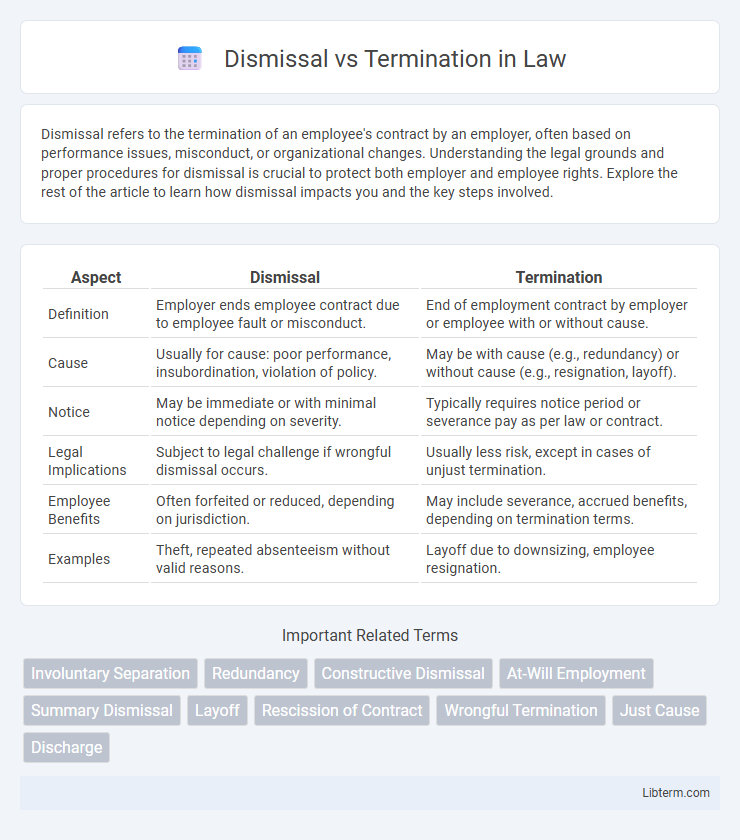Dismissal refers to the termination of an employee's contract by an employer, often based on performance issues, misconduct, or organizational changes. Understanding the legal grounds and proper procedures for dismissal is crucial to protect both employer and employee rights. Explore the rest of the article to learn how dismissal impacts you and the key steps involved.
Table of Comparison
| Aspect | Dismissal | Termination |
|---|---|---|
| Definition | Employer ends employee contract due to employee fault or misconduct. | End of employment contract by employer or employee with or without cause. |
| Cause | Usually for cause: poor performance, insubordination, violation of policy. | May be with cause (e.g., redundancy) or without cause (e.g., resignation, layoff). |
| Notice | May be immediate or with minimal notice depending on severity. | Typically requires notice period or severance pay as per law or contract. |
| Legal Implications | Subject to legal challenge if wrongful dismissal occurs. | Usually less risk, except in cases of unjust termination. |
| Employee Benefits | Often forfeited or reduced, depending on jurisdiction. | May include severance, accrued benefits, depending on termination terms. |
| Examples | Theft, repeated absenteeism without valid reasons. | Layoff due to downsizing, employee resignation. |
Understanding Dismissal and Termination
Understanding dismissal involves recognizing it as the employer's decision to end an employee's contract due to performance issues, misconduct, or business needs, often requiring proper documentation and adherence to legal procedures. Termination encompasses the broader concept of ending an employment relationship, including voluntary resignation, retirement, and dismissal, with differing legal implications based on the cause. Analyzing dismissal and termination requires careful consideration of labor laws, employee rights, and contractual obligations to ensure compliance and avoid disputes.
Key Differences Between Dismissal and Termination
Dismissal refers specifically to an employer ending an employee's contract due to performance issues, misconduct, or violation of company policies, often implying fault on the employee's part. Termination is a broader term encompassing any end of employment, including resignations, layoffs, or mutual agreements, without attributing blame. Key differences lie in the cause and implications: dismissal suggests disciplinary action, while termination may occur for various reasons unrelated to employee behavior.
Legal Definitions of Dismissal and Termination
Dismissal refers to the employer's unilateral decision to end an employee's contract due to specific reasons such as misconduct, poor performance, or redundancy, often requiring legal justification under employment law. Termination is a broader term encompassing any end of the employment relationship, including resignation, mutual agreement, or dismissal, with varying legal implications depending on the context. Understanding the legal definitions is crucial for compliance with labor regulations and protecting the rights of both employers and employees.
Common Reasons for Dismissal
Common reasons for dismissal include poor job performance, violation of company policies, absenteeism, insubordination, and misconduct such as harassment or theft. Dismissal often occurs when employees fail to meet performance standards or breach workplace rules, leading employers to end the employment relationship. Understanding these causes helps organizations implement fair and legally compliant dismissal procedures.
Grounds for Employment Termination
Grounds for employment termination include misconduct, poor performance, redundancy, or violation of company policies, each justifying dismissal or termination based on severity and context. Dismissal typically occurs due to employee fault such as insubordination or unethical behavior, while termination may also result from non-fault reasons like organizational restructuring or expiration of contract. Legal compliance and clear documentation of grounds ensure protection against wrongful dismissal claims.
Rights of Employees in Dismissal Cases
In dismissal cases, employees have the right to receive a clear explanation for their dismissal along with evidence supporting the employer's decision. They are entitled to a fair hearing or disciplinary process before termination to ensure procedural fairness. Employees also possess the right to challenge wrongful dismissal by seeking legal recourse or filing complaints with labor authorities to protect their employment rights.
Employer Obligations During Termination
Employer obligations during termination include providing clear, documented reasons for dismissal and adhering to contractual and legal requirements such as notice periods and severance pay. Employers must ensure compliance with labor laws to avoid claims of wrongful termination or unfair dismissal. Proper communication and record-keeping are critical to safeguarding both the employee's rights and the company's legal standing during the termination process.
Appeal Processes: Dismissal vs Termination
Appeal processes for dismissal typically involve a formal review where employees can challenge the employer's decision based on procedural errors or unfair treatment, often following company grievance policies. Termination appeals may require evaluating the just cause, contract terms, or severance agreements, with some cases escalating to labor tribunals or courts for wrongful termination claims. Both processes emphasize documentation, evidence, and adherence to legal standards to protect employee rights and employer accountability.
Impact on Severance and Benefits
Dismissal typically refers to involuntary job loss due to employee performance or misconduct, often leading to forfeiture of severance pay and benefits. Termination, a broader category including layoffs and resignations, generally qualifies employees for severance packages and continuation of benefits under company policy or legal requirements. The specific impact on severance and benefits depends on the nature of termination, employment contracts, and local labor laws.
Preventing Unfair Dismissal or Termination
Preventing unfair dismissal or termination requires adherence to clear legal standards and proper documentation of employee performance and conduct. Employers must ensure that dismissal decisions are based on valid reasons such as misconduct, redundancy, or poor performance, following due process and providing the employee an opportunity to respond. Implementing transparent disciplinary procedures and seeking legal advice can significantly reduce the risk of claims related to wrongful or unfair dismissal.
Dismissal Infographic

 libterm.com
libterm.com